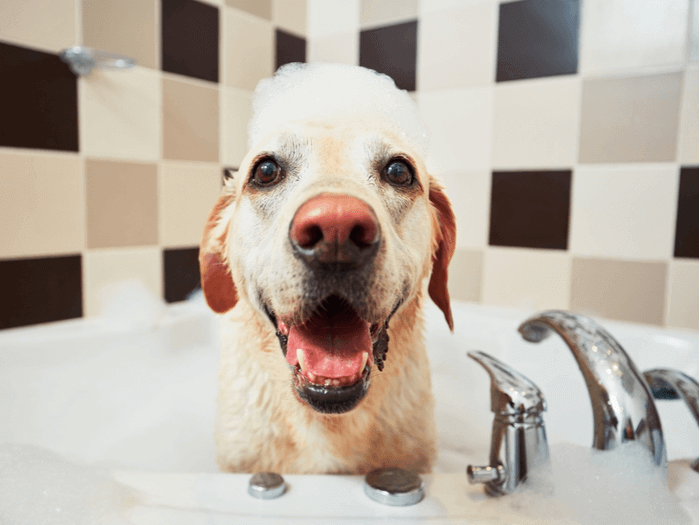Quarantine Dog Grooming Tips and Essentials

Bathing your dog no more than once a month is recommended, but it also depends on your dog breed, size, type of coat, and activities. The most recommended setup is to have 360- degree access to wash your dog. However, a normal bathroom tub also works, you can also consider getting a portable plastic tub and fill it with warm soapy water. Remember to place a rubber mat at the bottom of the tub to keep paws from moving around.
Step 1: Prepare your dog for bathing. Make sure to have dog treats ready to reward calm behavior when you place him at the location you want. Give your dog some time to make himself familiar with the environment by patting different parts of his body. Once your dog is comfortable with the environment, you can extend your touch to the footpads and nails.
Step 2: Introducing your dog to the bath equipment you are going to use. Praise your dog and give him treats after your introduction by showing and letting him feels the water temperature, towels and other equipment. Make your dog gradually get used to being in the tub.
Step 3: Use cotton balls to prevent water getting into the ears. Wet your dog’s hair all the way to the skin from the chest/neck area down to the tail. Avoid wetting the head area directly as dogs are very sensitive there. Also avoid eyes, ears, nose, and mouth areas. Stay cautious and use a washcloth to clean these areas instead. After you wet your dog, you can apply the shampoo. Massage the shampoo into his coat. Also, avoid shampoo to your dog’s head and face.
Step 4: Rinse your dog until the water from his fur runs clear. Use the washcloth to gently wipe away dirt from the eyes, ears, and face.
Step 5: Use a highly absorbent microfiber towel to dry your dog. Use hair dryer with a low heat setting for long fur.
Step 6: Comb your dog’s coat if he has long fur to avoid tangling.
Reminder: Remember to be patient, if you are trying this for the first time, you might need to pause your progress and stop when your dog gets upset. Try it on another day.
Use appropriate dog grooming equipment
Different dog’s fur and skin type might require different types of brushes. We found a very helpful article to help identify different brushes for dogs.

Slicker brush: removes knots and tangles and smooths fur (all dogs, especially long, medium hair)
Undercoat rake: removes loose undercoat hair easily and prevents matting (for double-coated dogs)
Flea comb: removes fleas, flea dirt and eggs from the coat (all dogs)
Rubber brush: removes loose hair, massages and can be used for shampooing (all coat lengths)
Double-sided brush: pon side removes tangles while the soft brush adds shine
Bristle brush: smooths hair and distributes healthy oil creating shine (all dogs coats)
Mat Breaker: breaks large mats of hair into manageable sections (all matted coats)
Moulting comb: Removes knots and hair from moulting coats
Grooming comb: Gently untangles knots without causing breakage
